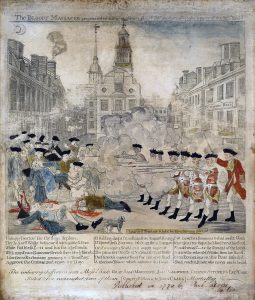Samuel Gray, son of Edward of Tiverton and Mary Manchester, was born in Tiverton in 1718. He married Lois Sampson of Dartmouth, Massachusetts in 1745 and had three children.
He later moved to Boston and became a ropemaker, working for John Gray’s Ropeworks (no relation). Samuel could be considered the first casualty of the Revolutionary War. He was the second man shot, but the first to die at the Boston Massacre on March 5, 1770.

On the cold, snowy night of March 5, 1770, a mob of angry colonists gathers at the Customs House in Boston and begins tossing snowballs and rocks at the lone British soldier guarding the building. The protesters opposed the occupation of their city by British troops, who were sent to Boston in 1768 to enforce unpopular taxation measures passed by a British parliament without direct American representation.
The previous Friday, British soldiers looking for part-time work and local Bostonian laborers had brawled at John Hancock’s wharf. (British soldiers competed for jobs and were paid less, thus lowering the wage for the locals. Ropemakers were always looking for workers and the British soldiers were willing to work in the dangerous sweatshop to make extra cash.) After the brouhaha escalated to include forty soldiers, their colonel, William Dalrymple confined them to their barracks. Peace settled over the city during the two-day observance of the Puritan Sabbath. However, tempers on both sides were still flaring and no one expected Monday, March 5, to pass without incident. After sunset, the brawl between Boston civilians and British soldiers began again.
When the customs-house sentinel called for assistance, a British corporal and seven soldiers came to his aid. Two of these reinforcements had been among the soldiers brawling on Hancock’s wharf the previous Friday. British Captain Thomas Preston assumed command of the riled Redcoats and ordered them to fix their bayonets. As the crowd dared the snow-pelted soldiers to fire, Private Hugh Montgomery slipped and fell, leading him to discharge his rifle into the jeering crowd. The other soldiers began firing a moment later, and when the smoke cleared, five colonists were dead or dying: Crispus Attucks, Patrick Carr, Samuel Gray, Samuel Maverick and James Caldwell. Three more were injured. Although it is unclear whether Crispus Attucks, a sailor of African and Indian ancestry, was the first to fall, as is commonly believed, the deaths of the five men are sometimes regarded as the first fatalities of the American Revolution.
The British soldiers were put on trial, and John Adams and Josiah Quincy Jr. agreed to defend the soldiers, in a show of support of the colonial justice system. When the trial ended in December 1770, only two of the six British soldiers were found guilty of manslaughter. They were branded on the thumb and released.
[from www.tapatalk.com]
